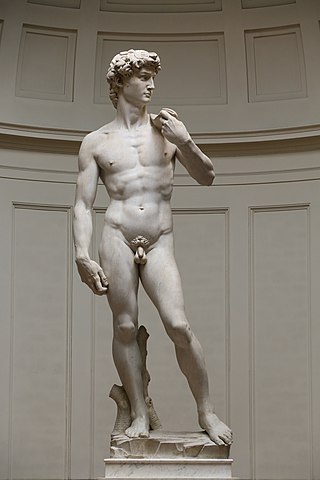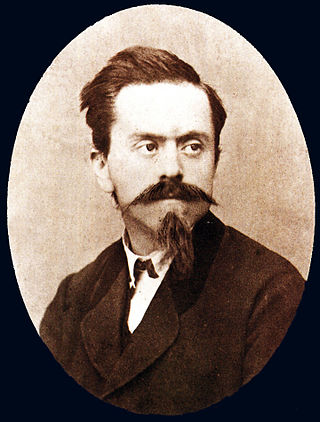
David is a masterpiece of Renaissance sculpture, created in marble between 1501 and 1504 by the Italian artist Michelangelo. David is a 5.17-metre marble statue of the Biblical figure David, a favoured subject in the art of Florence.

Donato di Niccolò di Betto Bardi, better known as Donatello, was a Florentine sculptor of the Renaissance period. Born in Florence, he studied classical sculpture and used this to develop a complete Renaissance style in sculpture. He spent time in other cities, and while there he worked on commissions and taught others; his periods in Rome, Padua, and Siena introduced to other parts of Italy his techniques, developed in the course of a long and productive career. Financed by Cosimo de' Medici, Donatello's David was the first freestanding nude male sculpture since antiquity.

The Pazzi Chapel is a chapel located in the "first cloister" on the southern flank of the Basilica di Santa Croce in Florence, Italy. Commonly credited to Filippo Brunelleschi, it is considered to be one of the masterpieces of Renaissance architecture.

The Bargello, also known as the Palazzo del Bargello, Museo Nazionale del Bargello, or Palazzo del Popolo, was a former barracks and prison, now an art museum, in Florence, Italy.

The English Cemetery in Florence, Italy is an Evangelical cemetery located at Piazzale Donatello. Although its origins date to its foundation in 1827 by the Swiss Evangelical Reformed Church, the name "English Cemetery" results from the majority of its burials being Protestants from the British and American communities of Florence, and who gave the largest sum of money for the purchase of its land. The cemetery also holds the bodies of non-English speaking expatriates who died in Florence, among them Swiss and Scandinavians, as well as Eastern Orthodox Christians, among them Russians and Greeks. The cemetery is still owned by the Swiss Evangelical Reformed Church, and is open for the interment of cremated ashes, now of all Christian denominations, but no longer for burials.

Giotto's Campanile is a free-standing campanile that is part of the complex of buildings that make up Florence Cathedral on the Piazza del Duomo in Florence, Italy.

The House della Gherardesca was an old noble family of the Republic of Pisa, dating back as early as the 11th century of Longobard origin.

Piazza della Repubblica is a city square in Florence, Italy. It was originally the site of the city's forum; then of its old ghetto, which was swept away during the improvement works, or Risanamento, initiated during the brief period when Florence was the capital of a reunited Italy—work that also created the city's avenues and boulevards. At that time, the Loggia del Pesce from the Mercato Vecchio was also moved to Piazza Ciompi. The square's Giubbe Rosse cafe has long been a meeting place for famous artists and writers, notably those of Futurism.

Giardino dell'Iris is a botanical garden specializing in the cultivation of iris flowers, symbol of Florence since 1251. It is located on the corner of Viale dei Colli and Piazzale Michelangelo in Florence, Italy, and open daily without charge from May 2–20 every year.
Piazzale Michelangelo is a square with a panoramic view of Florence, Italy, located in the Oltrarno district of the city.

Via Camillo Cavour is one of the main roads of the northern area of the historic city centre of the Italian city of Florence. It was created in 1861 from two older streets, Via Larga and Via Leopoldo, and renamed after Camillo Cavour on 17 June 1861, just 11 days after his death.

The historic centre of Florence is part of quartiere 1 of the Italian city of Florence. This quarter was named a World Heritage Site by UNESCO in 1982.

The Viali di Circonvallazione are a series of 6-lane boulevards surrounding the north part of the historic centre of Florence.

Piazza del Duomo is located in the heart of the historic center of Florence. It is one of the most visited places in Europe and the world and in Florence, the most visited area of the city. The square contains Florence Cathedral with the Cupola del Brunelleschi, the Giotto's Campanile, the Florence Baptistery, the Loggia del Bigallo, the Opera del Duomo Museum, and the Arcivescovile and Canonici's palace. The west zone of this square is called Piazza San Giovanni.

The Battistero di San Giovanni is a religious building in Siena, Italy. It is in the square with the same name, near the final spans of the choir of the city's cathedral.

The Museo dell'Opera del Duomo in Florence, Italy is a museum containing many of the original works of art created for the Cattedrale di Santa Maria del Fiore, the cathedral (Duomo) of Florence. As of August 2013, the director of the museum is Fr. Timothy Verdon, an American.

TheCimitero Evangelicoagli Allori is located in Florence, Italy, between 'Due Strade' and Galluzzo.

The Parco delle Cascine (Cascine Park) is a monumental and historical park in the city of Florence. The park covers an area of 160 hectares. It has the shape of a long and narrow stripe, on the north bank of the Arno river. It extends from the centre of Florence until the point where the Mugnone flows into the Arno.

Tito Chelazzi was an Italian still-life painter and war hero.





















